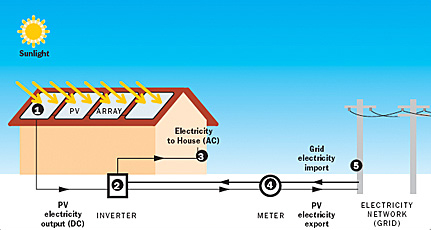Benefits of PV Grid Connected Solar
Solar energy is not only clean and sustainable it is a natural renewable source, producing zero emissions whilst converting the sun’s rays into usable electricity during this silent process.
Not only does PV grid connected solar power reduce your energy bills, it adds value to your home’s resale estimation and is the way of the future.
The return on investment averages approximately 10-15%
Breakdowns and faults are very rare with high quality panels as there are no moving parts. Maintenance is minimal once installed.
How Does Solar Work?
Solar Photovoltaic (PV) panels are generally fitted on the roof in a northerly direction or east/west split array and at an angle to maximise the amount of sunlight that hits the panels.

Traditional DC System
Solar PV panels on the roofs of homes and businesses generate clean electricity by converting the energy in sunlight. The conversion takes place within modules of specially fabricated materials that make up the solar panels. It is a relatively simple process that requires no moving parts.
In most cases, solar panels are connected to the mains power supply through a device called an inverter.
Most suburban homes in Australia are connected to the electricity grid, which uses Alternating Current (AC) electricity. But the electricity generated by solar panels is Direct Current (DC), which means that grid-connected solar PV systems need an inverter to transform the power to the DC that a household needs.
Houses with solar power use use solar power first before sourcing electricity from the grid. When the panels are not producing electricity at night, electricity is supplied from the existing electricity grid.
Types of PV Grid Systems
Traditional DC String System
This is the most common type of grid connect system. Typically, panels are wired in strings to a single central inverter – these systems are ideal for unshaded roof spaces. DC systems range from budget products to top of the range products. This type if system is not battery-ready and does not have an uninterruptible power supply function. A monitoring system (showing production of power only) is available.
DC Hybrid System
Very similar in design to the Tradtgional DC STring system, but Hybrid inverters have more functionality than Traditional inverters. Hybrid inverters are battery ready with compatible batteries and have an uninterruptible power supply function, so you have a backup circuit in the event of a grid shutdown – you need batteries for this to function. Hybrid systems generally have a very user-friendly monitoring system, showing both consumption and production.
Micro Inverters
A different type of system where each panel has its own micro-inverter wired in parallel rather than in series; there is no central inverter. Micro-inverter systems can be up to 25% more efficient than traditional string converters and are used in domestic and commercial situations. Ideal for roofs that have slight shading at certain times of the day or that need installations with varying orientations due to limited roof space. Enphase micro-inverter systems are also battery ready, compatible with their lithium iron phosphate batteries. However, at this stage they do not have backup circuit functionality. Enphase have a fantastic very user-friendly monitoring system that can be installed on your smart phone, tablet or computer. Another advantage is that this system is modular, so extending the system at a later date is easy.
Please note: If the grid has a blackout, both DC and AC systems will shut down.